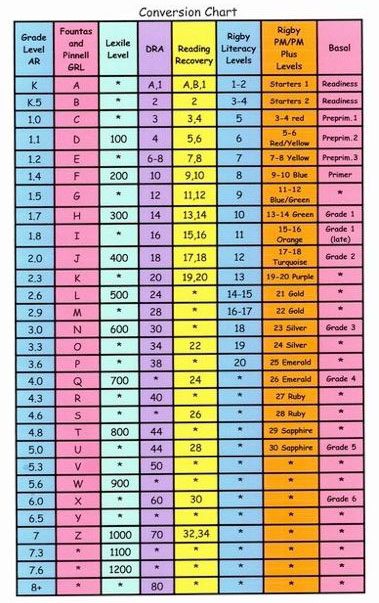A conversion table for reading level measurement tools
by Staff
If you have used AR (accelerated reader) as a reading motivation tool to define objectives and follow progress, you are undoubtedly aware of its ability to also assess general reading levels.
The problem is that the measurement of the reading level is really outside its Sweet Spot as a literacy tool, with better resources available from Dra, Dibels, Lexile, Reading Recovery and Rigby, among others. There is also the problem of availability, most schools using only one or two of these tools, mainly in early primary school. But what happens if you have to convert a general level from one program to another?
1. Framework Lexile for reading
Lexile.com
The Lexile framework is the most used tool in American schools. It measures both the complexity of the text and the reading capacity of a student on the same scale.
Advantages: integrated into many platforms (for example, MAP Growth, Buy3000), easy to match books in terms of students
Disadvantages: does not take into account basic knowledge or interests
Best for: 2+ classes, especially when used with adaptive assessments
2. Fountas & Pinnell (F&P)
Heinemann.com
This guided reading system A – Z uses teachers and execution observation records.
Positive points: rich qualitative insight, ideal for small groups
Disadvantages: long and somewhat subjective
Best for: guided K – 5 guided reading programs
3. DR (development of development of development)
Pearson assessments
Dra provides a level of reading based on mastery, precision and understanding.
Advantages: In -depth instantaneous of reading behaviors
Disadvantages: requires an individual test time
Best for: K – 3 Use of diagnosis
4. Star reading
Renaissance Learning: an IT adaptive test which quickly identifies the level of reading a student and ZPD (proximal development zone).
Advantages: fast, scalable, rich in data
Disadvantages: less diagnostic depth
Best for: Comparative analysis and screening from 2nd to 12th year
5. Reading diagnosis for implementation
I-Ready.com: This adaptive test provides a personalized preview of the students’ reading capacity and links directly to the educational content.
Advantages: detailed reports, integrated study program
Disadvantages: Owner system; requires complete membership
Best for: schools using i-feedy in all subjects
6. Read a – Z and raz -kids
Read a – Z | Razs
These programs affect students levels to students and allow an assessment being read.
Advantages: huge digital library, integrated questionnaires
Disadvantages: leveling does not always align with other systems
Best for: Daily reading practice and progress monitoring (grades K to 5)
7. Inventories of informal reading (IRIS)
Varies according to the publisher – The examples include the qualitative reading inventory and the basic reading inventory
Advantages: directed by teachers, provides rich information
Disadvantages: not standardized, takes time
Best for: Individual diagnosis and conference -based instruction
A conversion table for reading level measurement tools

A conversion table for reading level measurement tools



